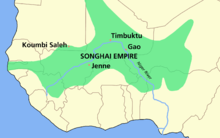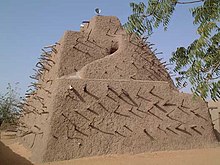Askia Muhammad I
| Askia Muhammad I | |
|---|---|
| Askia | |
| Reign | April 1493 – 1528 |
| Predecessor | Askia dynasty |
| Father | Abi Bakr |
| Mother | Kassey |
| Religion | Sunni Islam |

circa 1500.
Askia Muhammad I (1443–1538), born Muhammad ibn Abi Bakr al-Turi
Muhammad was a prominent general under the Songhai ruler
Ture subsequently orchestrated a program of expansion and consolidation which extended the empire from Taghaza in the North to the borders of
Name and origins
The Tarikh al-Sudan gives Askia Muhammad's name as Muhammad ibn Abi Bakr al-Turi or al-Sillanki.
After going on the hajj in 1497–1498, he also became known as Askia al-Hajj Muhammad.[7] In modern Songhai, he is known as Mamar Kassey.[8] Mamar is a form of the name Muhammad, and Kassey is a matronymic.

The theory that Askia Muhammad's family originated in Futa Toro is controversial and has been generally rejected by the
The term 'sonhinkey,' which suggests a Soninke ethnic origin for Askia, is also the name of a clan of Songhai magicians responsible for the pre-Islamic cult and forming a younger branch of the royal Sunni clan without rights to the throne. Songhai oral traditions claim the father of Askia Mohammed originated from this clan. Omar Komajago, Askia's brother, is never described as a Touré or a Sylla.
The term at-Turi, which designates the geographical origin of a person, could be the name of Askia's father's village. There is a Songhai village call Tureh in
Although Askia Mohamed is generally seen as the son of princess Kassey, sister of
Title
The title Askia
The original pronunciation of the title is not known; in modern Songhai, it is pronounced siciya.[10] Moroccan sources spelled the title Sukyā or Sikyā, Leo Africanus spelled it Ischia, and a contemporary Portuguese source spelled it Azquya.
Early life
Askia Muhammad was born in Gao. His father, Baru Lum,[c] was of Toucouleur or Soninke ancestry, with ancestors hailing from the Senegal River valley.[d] His mother was named Kassey[e] and is said in oral tradition to have been the sister of Sonni Ali.[19]
Rebellion
Under Sonni Ali, Muhammad Ture was a powerful general but frequently clashed with the king. The Tarikh al-Fattash paints him as a faithful Muslim opposed to Ali's harsh treatment of the ulama of Timbuktu.[20]
In 1492, shortly after the death of Sonni Ali, Muhammad Ture, then a general, rose up against Ali's son Sonni Baru, claiming he was not a faithful Muslim. He drew his support from the ulama of Timbuktu, harshly persecuted under Ali, and Mansa Kura, the Muslim chief of Bara. Sonni Baru drew his from the traditional religious leaders of the Songhay and the Dendi fara, commander of an eastern province.[20] Ture defeated Baru at the Battle of Anfao in April 1493 outside of Gao and took power and the title 'Askia'.[21]
Reign
In 1496 he made the
Upon his return, he embarked on a series of campaigns against the
In 1512, his brother Omar Komajago led an army that destroyed Futa Kingi, killed Tenguella, and brought the Kingdom of Diarra under the empire's sway.[27] 1515 saw another campaign against Agadez, reinforcing the Songhai position there. This was the peak of his power. Askia Muhammad had earlier conquered Katsina, Zaria and Gobir, devastating the cities with slave-taking and heavy taxation. The expedition against Agadez caused dissession when the Emir of Kebbi felt he had been cheated of his share of the spoils and rebelled, ending Songhai hegemony in Hausaland.[28]
Reforms
Askia Muhammad profoundly reorganized the Songhai empire. Where Sonni Ali had been a diffident Muslim, Askia was devout. He based the legal system on
Askia Muhammad created a professionalized army, rather than the general levy that his predecessors had commanded. These soldiers, legally slaves of the Askia, could be sent on long expeditions away from the
Exile and death
Askia Muhammad had many sons, who jockeyed for position and influence at court. When a younger one, Bala, was appointed to a presitigious governorship, Musa threatened to have the king's powerful advisor 'Ali Folon killed and drove him to exile in Tindirma in 1526. He had been concealing the fact that Muhammad, well over 70 years old, had gone blind.[30] Ill and increasingly politically isolated, Askia Muhammad was forced to abdicate by his son Askia Musa in August 1528. Musa reigned only 3 years before being killed by his brothers.[12]: 22 His successor, the son of Omar Kondjago and Muhammad's nephew, exiled the old king to an island in the Niger. From here, he plotted with his son Ismail to retake the throne. This was accomplished in April 1537, and Muhammad returned to Gao where he ceremonially conferred on Ismail the title and regalia of Caliph.[31] He died and was buried in Gao in 1538.[21]
Descent from Askia
The Tarikh al fattash reports the many descendants of Askia Muhammad, who is said to have had 471 children from many wives and
Mamar Haamey
Mamar is the nickname of Askia Muhammad and these many descendants are called mamar hamey, they are the descendants of
The descendants of the askia like that of sunni carry the title of Maiga associated with imperial power.
Songhai Djermas
The descendants of the Askia are also to be found mainly among the
Matrimonial relations between the askia and the za are the basis of cousinhood between the Songhai djermas and the
The descendants of the
The Djerma, the mamar hamey and the si hamey all qualify as zaberbenda (the descendants of za the great, za el ayaman) and must support each other in the event of an enemy attack, when the mamar haama are attacked on the right bank, the Tubal
Hausa land
Askia Mohamed I is the maternal ancestor of the
All Hausa descendants of Muhammad Rumfa sultan of Kano are matrilineal line descendants of Askia.[33]
Others
The
Throughout the Central Sahel, the descendants in patrilineal or matrilineal line of the askia can be around Million drawn from the ethnic Songhai which amounts to nearly 11 million people and possible descendants among the
Are sons the
The successions on the imperial Songhai throne are generally preceded by a battle between the princes, the strongest generally takes power, it is this instability which favored the Moroccan invasion and the defeat of Tondibi due to a weak contribution of troops resulting from the cold between the emperor Ishaq II and the balama of the kurmina.[35]
Legacy
Askia encouraged learning and literacy, ensuring that Songhai's universities produced the most distinguished scholars, many of whom published significant books and one of which was his nephew and friend Mahmud Kati. To secure the legitimacy of his usurpation of the
In popular culture
- The Nigerien musical group Mamar Kasseyis named after Askia Muhammad.
- In the turn-based strategy game
See also
Footnotes
- ^ Or, it is said, al-Sillanki
- ^ Or Askiya
- ^ Baru is a Songhai form of the name Abu Bakr.[4] Lum is a clan name, probably of Fula origin.[15]
- Futa Toro or Silla in the Senegal valley. Futa Toro was predominantly Toucouleur and Silla was predominantly Soninke.[6]
- ^ Spelling variants: Kasay,[16] Kassaye,[8] Kassaï,[17] Kassey, Kassai, and Kasse[18]
References
- ^ Towards an Understanding of the African Experience from Historical By Festus Ugboaja Ohaegbulam
- ^ Biographical information on historical African figures from globaled.org
- ^ Muḥammad I Askia Songhai ruler from britannica.com
- ^ a b Hunwick 1999, p. 102.
- ^ Bühnen 2005, p. 85.
- ^ a b Bühnen 2005.
- ^ Bühnen 2005, p. 83.
- ^ a b Johnson, Hale & Belcher 1997, p. 126.
- ^ Boubou Hama (1967). L'Histoire traditionnelle d'un peuple, les Zarma-Songhay (in French). Présence africaine.
- ^ a b Hunwick 1999, p. 335.
- ^ de Moraes Farias 2008, p. 102.
- ^ a b Page, Willie F. (2005). Davis, R. Hunt (ed.). Encyclopedia of African History and Culture (Illustrated, revised ed.). Facts On File.
- ^ Gomez 2018, p. 226.
- ^ Hunwick 1999, p. 103.
- ^ Bühnen 2005, p. 89.
- ^ Hunwick 1999, p. 181.
- ^ Houdas & Delafosse 1913, p. 114.
- ^ Bellama 1970.
- ^ Johnson, Hale & Belcher 1997, p. 126–127.
- ^ a b Levtzion 1977, p. 427.
- ^ a b c d "Muhammad I Askia". Encyclopedia Britannica. Retrieved 10 June 2023.
- ^ Green, Toby (2020). A Fistful of Shells. UK: Penguin Books. p. 62.
- ^ a b Levtzion 1977, p. 428.
- ^ Turchin, Peter and Jonathan M. Adams and Thomas D. Hall: "East-West Orientation of Historical Empires and Modern States", page 222. Journal of World-Systems Research, Vol. XII, No. II, 2006
- ^ Kane, Oumar (2021). "La Formation du Royaume Jaalalo du Kingi par Tenghella". In Fall, Mamadou; Fall, Rokhaya; Mane, Mamadou (eds.). Bipolarisation du Senegal du XVIe - XVIIe siecle (in French). Dakar: HGS Editions. p. 54.
- ^ Levtzion 1977, p. 432.
- ^ Niane, Djibril Tamsir (2005). "Mali Empire: Decline, Fifteenth Century". In Shillington, Kevin (ed.). Encyclopedia of African History. New York: Fitzroy Dearborn. pp. 921–922.
- ^ Levtzion 1977, p. 433.
- ^ Levtzion 1977, p. 430.
- ^ Levtzion 1977, p. 434.
- ^ Levtzion 1977, p. 436.
- ^ Hunwick 1999, p. 180 n40.
- ^ "Concubines and Power: Five Hundred Years in a Northern Nigerian Palace". epdf.tips. Retrieved 4 February 2023.
- ^ a b Hunwick 1999, p. 184 n68.
- ^ "The Invasion of Morocco in1591 and the Saadian Dynasty". University of Pennsylvania – African Studies Center.
- ISBN 0-7619-8902-1.
- ^ Johnston 2010.
Primary sources
- al-Sadi, Taʾrīkh al-Sūdān, translated in Hunwick 1999
Other sources
- Bellama, David (1970). Si Ali and Askia Mohammed: two interpretations: the Muslim chronicles vs. Songhay oral tradition.
- Bühnen, Stephan (2005). "Askiya Muḥammad I and his qabīla: name and provenance". Sudanic Africa. 1: 83–90. JSTOR 25653427.
- Gomez, Michael A. (2018). ISBN 978-0-691-17742-7.
- Houdas, O.; Delafosse, M. (1913). Tarikh el-Fettach ou Chronique du Chercheur, par Mahmoûd Kâti ben El-Hâdj el-Motaouakkel Kâti et l'un de ses petits-fils. Paris.
{{cite book}}: CS1 maint: location missing publisher (link) - Hunwick, John O. (1999). Timbuktu and the Songhay Empire: Al-Saʻdi's Taʼrīkh al-Sūdān down to 1613, and other contemporary documents. Islamic history and civilization : studies and texts. Leiden; Boston: Brill. ISBN 978-90-04-11207-0.
- Johnson, John William; Hale, Thomas A.; Belcher, Stephen, eds. (1997). Oral epics from Africa: vibrant voices from a vast continent. Indiana University Press. ISBN 0-253-21110-7.
- Johnston, Casey (2010-09-20). "Statecraft as entertainment: Ars reviews Civilization V". Ars Technica. Retrieved 2022-02-07.
- de Moraes Farias, Paulo F. (2008). "Intellectual innovation and reinvention of the Sahel: the seventeenth-century Timbuktu chronicles". In Jeppie, Shamil; Diagne, Souleymane Bachir (eds.). The meanings of Timbuktu. Cape Town: HSRC Press. ISBN 978-0-7969-2204-5.
- Josef W. Meri; Jere L. Bacharach (2006). Medieval Islamic Civilization: L-Z, index. Taylor & Francis. p. 764. ISBN 978-0-415-96692-4.
- ISBN 9781139054577. Retrieved 12 March 2024.
- Stoller, Paul (1992), The Cinematic Griot: The Ethnography of Jean Rouch, University of Chicago Press, p. 105, ISBN 9780226775487, retrieved 2021-06-04
